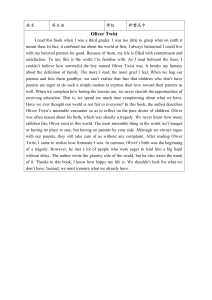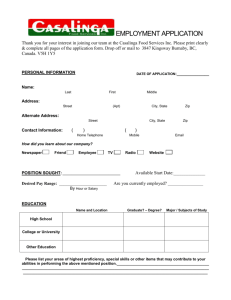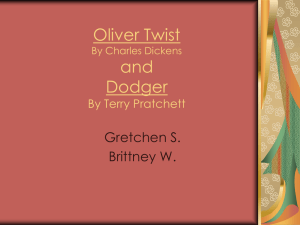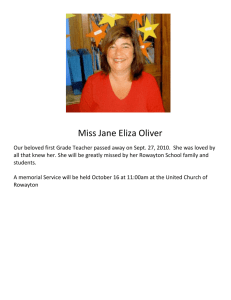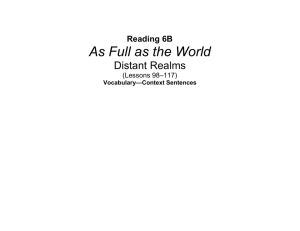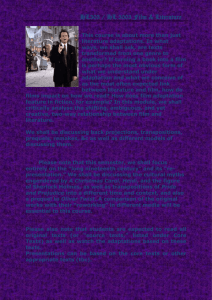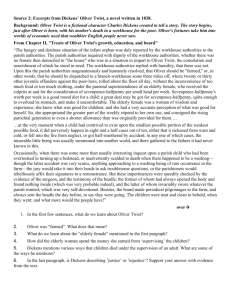Oliver Twist 05.11
advertisement
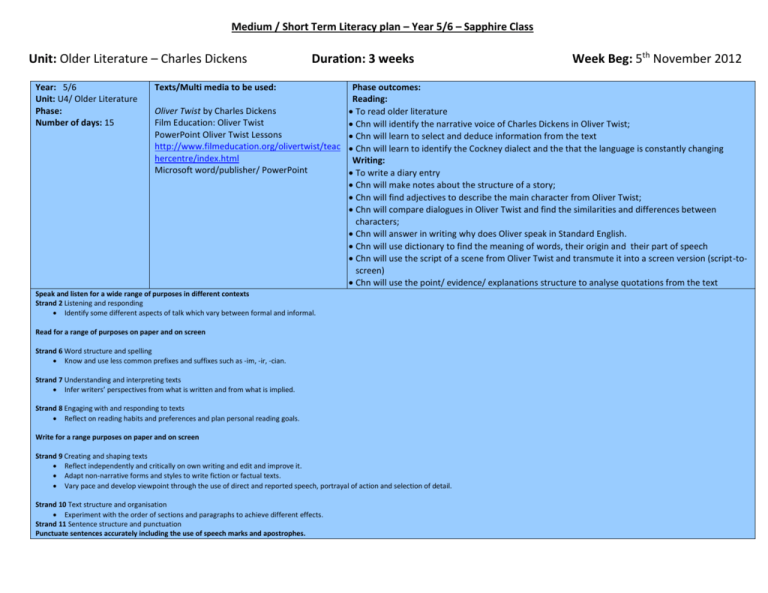
Medium / Short Term Literacy plan – Year 5/6 – Sapphire Class Unit: Older Literature – Charles Dickens Year: 5/6 Unit: U4/ Older Literature Phase: Number of days: 15 Duration: 3 weeks Texts/Multi media to be used: Week Beg: 5th November 2012 Phase outcomes: Reading: Oliver Twist by Charles Dickens To read older literature Film Education: Oliver Twist Chn will identify the narrative voice of Charles Dickens in Oliver Twist; PowerPoint Oliver Twist Lessons Chn will learn to select and deduce information from the text http://www.filmeducation.org/olivertwist/teac Chn will learn to identify the Cockney dialect and the that the language is constantly changing hercentre/index.html Writing: Microsoft word/publisher/ PowerPoint To write a diary entry Chn will make notes about the structure of a story; Chn will find adjectives to describe the main character from Oliver Twist; Chn will compare dialogues in Oliver Twist and find the similarities and differences between characters; Chn will answer in writing why does Oliver speak in Standard English. Chn will use dictionary to find the meaning of words, their origin and their part of speech Chn will use the script of a scene from Oliver Twist and transmute it into a screen version (script-toscreen) Chn will use the point/ evidence/ explanations structure to analyse quotations from the text Speak and listen for a wide range of purposes in different contexts Strand 2 Listening and responding Identify some different aspects of talk which vary between formal and informal. Read for a range of purposes on paper and on screen Strand 6 Word structure and spelling Know and use less common prefixes and suffixes such as -im, -ir, -cian. Strand 7 Understanding and interpreting texts Infer writers’ perspectives from what is written and from what is implied. Strand 8 Engaging with and responding to texts Reflect on reading habits and preferences and plan personal reading goals. Write for a range purposes on paper and on screen Strand 9 Creating and shaping texts Reflect independently and critically on own writing and edit and improve it. Adapt non-narrative forms and styles to write fiction or factual texts. Vary pace and develop viewpoint through the use of direct and reported speech, portrayal of action and selection of detail. Strand 10 Text structure and organisation Experiment with the order of sections and paragraphs to achieve different effects. Strand 11 Sentence structure and punctuation Punctuate sentences accurately including the use of speech marks and apostrophes. Word/Sentence Level Learning Intention Have a set of words on the board – can the children rearrange to create a sentence – where are the nouns, verbs, adjectives? 1 Main Learning Intention To find out background information about the Victorian era to help you place Oliver Twist in a social and historical context Read Chapters 1 and 2 of Oliver Twist to the children. Success Criteria/ Targets By outcome on this occasion: Chn will identify the narrative voice of Charles Dickens in Oliver Twist; Chn will learn to select and deduce information from the text Example of Direct Teaching Explain to the children that the Unit is going to look at old literature – Oliver Twist by Charles Dickens. This includes historical information on workhouses and life in Victorian London, helping you to develop a picture of what Britain was really like at the time. Using this historical information, you can contrast the lives of rich and poor during Victoria's reign and consider how Dickens' novel reflects this. Oliver Twist reflects a major thematic concern for author Charles Dickens, that of social justice. This is reflected in his description of character types and narrative structure. His interest and concern with highlighting the plight of the poor and the attitudes within society towards them. Tell chn. that Dickens was concerned with writing for a wide increasing literate public, meaning that his audience were able to recognise his shape characterisations and insightful social commentary. Key questions and assessment What clues the writer gives about Oliver Twist? How the author does keep the interest of the reader? What is narrative voice? What is the tone used by a writer? Diff Activities Focus group in bold. Pupils research about Oliver’s London, Rich and Poor, about Dickens on the website www.filmeducation. org . They make notes for each topic and try to analyse what they found out by comparing with today’s society: Examples: Oliver’s London vs. Teacher’s London Rich & Poor in Victorian times vs. Rich & Poor today Plenary Take feedback from the children about their deductions. Chn to play the game on the Activities page on the filmeducation website (http://www.filmeducation.org/ol ivertwist/activities/game.html ). Explain that they will have to answer questions correctly to avoid the three terrible fates that await the character. If you don't know the correct answer then you can take a guess but be careful: if you fail to answer enough questions correctly this orphan's story may not have a happy ending! AFL Children to add information found to the working wall. 2 Children to have a copy of first 2 chapters of Oliver Twist. Children to scan read and highlight any unfamiliar words. Look up in dictionary for definition and add to working wall. SEN children to have words To explore a theme contained within the text Context: diary entry/tho ught bubble of Oliver (poor) * Think of Oliver in a particular situation * What might he be thinking or feeling? Recap what has happened in the first 2 chapters of Oliver Twist. Children to discuss in groups of 4. Children to write down 1 thing that has happened in the first two chapters of the novel. Move to next table and add to their groups sheet – by the end should have a good understanding of the first two chapters. Add to working wall. What is the main theme Dickens is trying to portray – the difference between rich and poor. Get children to stand in two opposite lines facing each other. Explain that this is a conscience alley – explain that this process helps us understand the decision a character has to make in a story. At the start Oliver is deciding SN – thought bubbles of Oliver when he was told he was going to have to ask, as he was walking towards Mr Bumble and in the cellar. LA – as above but extend sentences to think carefully about his feelings. MA – to write a short diary entry of the day when he ‘asked for more’. Plenary Choose chn to read their diary entries/thought bubbles and conclude how many of us like living in a city and how many wished to have lived in a rural place and why. prepared for them in CinP – use dictionary to find definition. AFL Read Chapter 3 and 4 at some point during the day. 3 AFL 4 AFL 5 AFL whether to ‘ask for more’. As the character walks down the ‘alley’ whisper their thoughts to Oliver. Model to the children the thought bubble of Oliver as he walked towards Mr Bumble. HA – to write a short diary entry of the day when he ‘asked for more’
